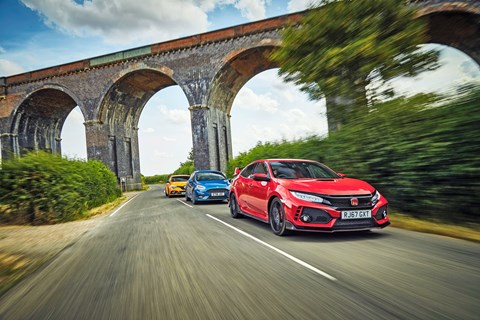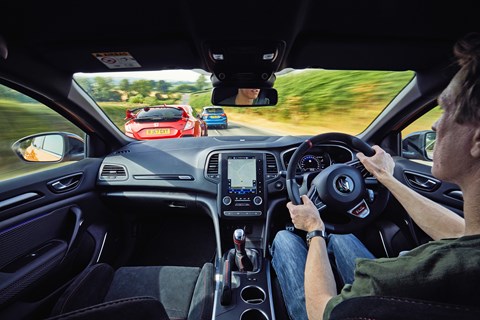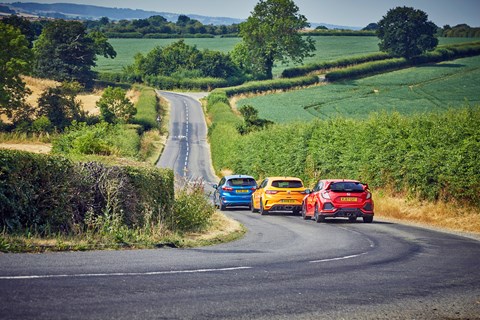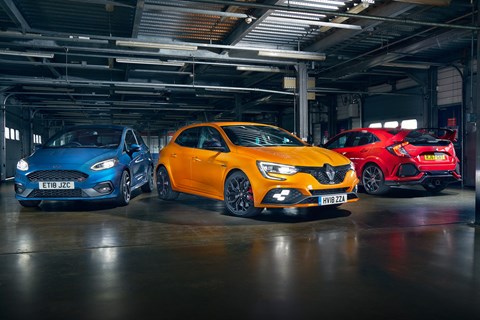► 2018’s top hot hatches battle
► Megane, Civic and Fiesta
► Odd mix, these cars matter
The Fiesta might be a rung down the hot hatch ladder, it might not be pushing 300bhp or jostling for the front-drive Nürburgring record currently held by the Type R, but we know better than to underestimate the hot hatch world’s Ant Man on real roads.
When we say ‘real roads’, too often we mean fantasy stretches of tarmac that are only handily nearby if you’re Highland cattle. But this time we’re keeping it local. We spend a lot of time at Rockingham because it’s a fun track but the lanes around it are so good, the brakes are often smoking as we roll onto the track, never mind off it.
We’ll be doing our best to smoke what’s left of the brakes today, but then we’ll also dial back the pace and do the whole thing again, because what matters on the track isn’t necessarily what matters on the road. Sure, we’re interested in how fast you can cover ground, but we’re more concerned with whether you have fun getting from A to B on the way at the kind of speeds you can get away with.
The Megane RS, Civic Type R and Fiesta ST are catching their breath in the paddock at Rockingham, each gently ticking to a different beat as cooling metal contracts, like three clocks set a fraction of a second adrift of each other. Which keys would you grab first?
I’m guessing you’d pick the Megane. It looks sensational, like an AMG A45 after three months of pumping and preening in preparation for a place on Love Island. Those wide hips (45mm wider than the Megane GT‘s) give it a real muscular stance that makes it impossible not to stop and stare, and fortunately this display doesn’t fall apart when you get close enough to scrutinise the details.
We’re talking about the Renault Sport chequered flag motif played out in the foglight design, the stretched and vented front wings and, on our car, two key options housed inside them: £950 of handsome 19-inch ‘Interlagos’ forged alloy wheels, and the Brembo bi-material brakes visible through their exquisitely delicate-looking spokes. Combining a steel disc and aluminium hub, the bi-material brakes lighten each corner to the tune of 1.8kg – and your wallet by a total of £900. We’ve seen some of these jewels before, but the overall impression is of a classier Megane attempting to move clear of simply pandering to the trackday crowd and firmly into hot Golf territory.
Which makes it the polar opposite of the loudmouth Civic.

As brutal as a concrete tower block, the Type R is Mr Hyde to the sober-suited Golf R’s Dr Jekyll. You’ll either love the way it looks or you won’t, and even if you love it, you won’t love all of it. The fake honeycomb grilles plastered over both ends do their utmost to kill the authenticity and credibility of a car we know to be both authentic and credible under its questionable skin, while the bonnet scoop feeding air to the most powerful engine here, the rear diffuser, that mutha of a rear wing and the little aero thingies at the trailing edge of the roof help claw some self respect back for the engineering team.
Grotesque it might be, but the Civic R and its ludicrous triple-tailpipe exhaust looks like it means business, which, as James Taylor found out on the night before the shoot, means every hot hatch driver in the vicinity wants to try his luck. I wish them the best of it, because you’d need more than luck to keep pace with a Civic Type R along a fast, narrow B-road. You’d need a serious bit of machinery in the Nissan GT-R league, and the balls to use it properly.
German hot hatches like the Audi RS3 and AMG A45 might be pushing on 400bhp, but the Civic’s three-twenty looks like plenty, and not just because Type R weighs almost 200kg less. This latest Honda 2.0-litre still sounds disappointingly flat compared to the screaming naturally-aspirated VTECs of old, but it’s massively strong, a significant 40bhp punchier than the Megane, and feels it, even if the 5.7sec-plays-5.8sec 0-62mph stats don’t bear it out.
Visually, the inside of the Type R is as much a mess as the outside. There’s the nasty red leather on the steering wheel and the even nastier low-tech analogue fuel and temperature gauges either side of the central speedo that look like some kind of crude Tomy kids’ toy. But the fundamentals are right, and righter than they have ever been. Compared with the previous Type R this one features a lower seat that pinches you like a proper FIA-spec bucket. It’s the sort of pinch that seems a little tight – right up until the point where you bundle the car into a serious third-gear B-road bend and bury the right pedal.
The Type R is one of those rare cars where everything just clicks the moment you set the wheels rotating. It corners with barely a hint of roll but the new multi-link rear suspension gives it the kind of composure that’s a genuine shock given the Fast and the Furious silhouette. So it’s both comfortable and it can get its power down – a fairly essential skill when you’ve got the kind of power that was 911-spec only a few years ago. The steering is quick and clean, and barely corrupted by torque steer. The gearshift is light and short of throw, its only negative feature the polished alloy shift ball that can get slippery in your hand.

There’s an organic feel to the whole experience, something you don’t get in many cars. Something you don’t get in the Megane. Because the Megane’s more complicated, less intuitive to fathom. It starts the moment you drop into a seat that’s more trough than bucket. It looks fabulous and those bolsters ought to offer plenty of support – provided you’re fat enough to buy your trousers at a clown outfitters. For me, in my summer coat at least, those seats simply aren’t snug enough. And they need to be because the Megane is every bit as rapid through the bends as the Civic. Not as analogue, mind. The body control is incredible but the ride on this car’s lower, stiffer Cup-spec suspension isn’t as good as the Honda’s and there’s more torque steer despite both using similar technology to separate the front strut from the hub. But the biggest mind bender is the 4Control four-wheel steering system. It feels more natural here than in the slower Megane GT, but it still takes a couple of miles to understand how the car’s going to react at different corners taken at different speeds. Or even the same corner taken at different speeds. Get your head around it, remembering that the changeover speed from rear wheels steering into the corner to them pointing away from them is different depending on which of the myriad drive modes you’ve selected, get comfortable with the unusual, imagined oversteer sensation on tight corners and it starts to feel pretty special.
Sounds special, too, at least in Race mode, when the tuneless drone of the Megane’s 276bhp 1.8-litre engine morphs into a hard-edged growl that sounds so good you’ll not care that it’s microchip assisted. You’ll be too busy wondering why the huge, cheap-looking media screen and its jumbo rotary control looks like one of those fake TVs Ikea used to dress its showroom sets with; why there are so many driving modes; or why the six-speed manual gearbox feels so obstinately clunky. Clunky enough that, despite the spot-on ratios, you might actually find yourself wishing you had two pedals and two paddles instead. And for once you can. Unlike Honda and Ford, whose hot hatches are exclusively manual, Renault gives Megane buyers the option4 to choose. And if we were choosing a Megane exclusively for road use, we’d probably swallow our macho pride, go for the more compliant non-Cup chassis and put the £1500 saved towards the dual-clutch transmission option.
When the Megane and Honda can cover so many bases from lunatic trackday toy to mini GT, how can the little Fiesta hope to compete? Visually, it can’t. It’s not totally devoid of performance presence: there’s a smart honeycomb grille at the front and those Marmitey wheels, which look like an ’89 XR2i’s spun out in a centrifuge, are teased right out to the edges of all four wheelarches thanks to a wider track. But apart from the discreet ST badge on the boot, there’s little to tell you this is Ford’s kindergarten supercar rather than an ordinary shopping-grade Fiesta. Nothing to tell you it’s an up-scale ST-2 unless you peer in and clock the bigger touchscreen; nothing to tell you it’s fitted with the optional £850 Performance Pack that brings goodies like the limited-slip differential, launch control and shift lights. Nothing at all to suggest it tears down the road like Warner Brothers’ Tasmanian Devil after a dozen cans of Red Bull.

It really does. Between us we’ve owned plenty of iconic ’80s and ’90s hot hatches, the kind of cars forum bores will tell you they don’t make any more. They’re right. The new ones are even better. Charge up to a corner, pile on the lock and bail out of the gas and the ST throws itself so sideways you’ll be crying with laughter when you finally get the thing gathered up. Modern cars – with their massive tyres, over-zealous stability systems and equally over-zealous corporate lawyers – rarely let you get up to that kind of mischief these days. But the Fiesta will. Clearly Ford trusts you – and clearly has some awesome lawyers.
You don’t have to drive it like that to get your kicks, though. You can dip into that same old-school throttle adjustability just a little to sharpen your lines, or not at all if you keep the stability system engaged. Then you’ll focus on the Mini-like steering that accentuates the short wheelbase and the gutsy 1.5-litre triple and its sweet-shifting six-speed manual sidekick that could only be better if the stick was mounted a smidge higher. Outgunned by the Civic to the tune of 120bhp, and taking a retro 6.5sec to hit 62mph, the Fiesta ought to feel disappointingly torpid. But it never does because you’re always right in the thick of the action. It’s the best small fast hatch on the planet, and at the £18,995 price Ford is asking for the entry-level ST-1 – and it’s debatable that you’d need more – it’s an absolute bargain.
But it’s not the best outright hot hatch. Because entertaining as it is, the Fiesta can get a little OTT. The ride, for instance, is still punishingly stiff, even if Ford has smoothed off the old car’s sharper edges. And the Performance Pack car’s LSD that so capably hooks you into the apex of a corner doesn’t have the benefit of the clever front struts fitted to the Civic, Megane and hotter versions of its Focus brother. Really wring the Fiesta’s neck and there’s no time for slacking off – on rough roads the steering can get pretty busy and, just occasionally, it feels like it wants to send you into the scenery. The ST is something to be enjoyed in short bursts, when you can expend every last drop of brainpower giving the car the attention it deserves. It’s the car that enlivens the 10-minute thrash to the station before your long daily commute to work on the train. The car you buy when you’ve already tried splurging £20,000 on a timewarp Peugeot 205 GTi only to discover it’s not nearly as much fun as you remember it being. And quite possibly the one current hot hatch you’d pick if you had that much-pondered ‘one last gallon’ to burn through before the end of the world.

But if you had a whole refinery’s worth of the stuff? Then you’d take the Civic. That’d give you enough time to get used to the freakshow styling and the stares it garners, to reconcile with the slightly disappointing soundtrack and the crude aftermarket-style multimedia system. But not to get bored. I’m not sure there’s enough oil left in the ground for that to happen. The Civic appeals because it’s brilliantly absorbing when you’re on it, and surprisingly great company when you’re not. But also because there’s a simple honesty to the way it drives. Right now, it’s still the best hot hatch you can buy.
Megane RS vs Fiesta ST vs Civic Type R
First place: Honda Civic Type R
The Honda’s reign goes on – so intuitive and so intoxicatingly talented. Forget the looks, the Civic Type R is a beauty.
Second place: Ford Fiesta ST
Physical when you’re on it and the ride is hard work when you’re not, but it’s playful brilliance is the distilled essence of hot hatch fun.
Third place: Renault Megane RS
Cup chassis a treat on track, once you’ve adjusted to its quirks, but there are too many niggles – not least the gearshift.
Specifications
Renault Megane RS
Price £27,495 (£35,245 as tested)
Engine 1798cc 16v turbocharged four-cylinder, 276bhp @ 6000rpm, 288lb ft @ 2400rpm
Transmission Six-speed manual, limited-slip diff, front-wheel drive
Performance 5.8sec 0-62mph, 158mph, 39.2mpg, 163g/km CO2
Suspension MacPherson strut front, torsion beam rear
Weight 1407kg
Ford Fiesta ST
Price £18,995 (£22,965 as tested)
Engine 1499cc 12v turbocharged three-cylinder, 197bhp @ 6000rpm, 214lb ft @ 1600rpm
Transmission Six-speed manual, limited-slip diff, front-wheel drive
Performance 6.5sec 0-62mph, 144mph, 47.1mpg, 136g/km CO2
Suspension MacPherson strut front, torsion beam rear
Weight 1262kg
Honda Civic Type R
Price £30,995 (£32,995 as tested)
Engine 1996cc 16v turbocharged four-cylinder, 316bhp @ 6500rpm, 295lb ft @ 2500rpm
Transmission Six-speed manual, limited-slip diff, front-wheel drive
Performance 5.7sec 0-62mph, 169mph, 36.7mpg, 176g/km CO2
Suspension MacPherson strut front, multi-link rear
Weight 1380kg